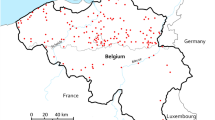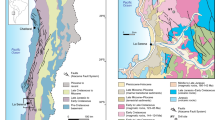Abstract
WEATHERING of rocks as the result of pressures exerted by the crystallization of salts from solutions in confined spaces has been recognized for many years. Studies of crystal growth pressures have been summarized by Buckley1. The roles of such pressures in rock weathering have been described by Birot2, and analysed by Wellman and Wilson3, who stated that for rocks of equal mechanical strength those with large pores separated from each other by microporous regions are most liable to salt weathering. The process is pronounced in desert and coastal areas. It is likely to be most effective (i) in the humid deserts of western littorals where the supply of salts from fogs and chemical weathering is accompanied by frequent wetting and drying of the surface, and (ii) around the margins of playas and along channels in desert areas where salts tend to be concentrated and wetting and drying is most frequent. We accept the effectiveness of salt crystallization pressures, the Salzsprengung of German authors, but we suggest that there are two additional factors associated with salts which may lead to the disintegration of rock: (i) stresses exerted by the expansion of many salts in confined spaces as they are heated, and (ii) stresses caused by hydration of certain salts in confined spaces.
This is a preview of subscription content, access via your institution
Access options
Subscribe to this journal
Receive 51 print issues and online access
$199.00 per year
only $3.90 per issue
Buy this article
- Purchase on Springer Link
- Instant access to full article PDF
Prices may be subject to local taxes which are calculated during checkout
Similar content being viewed by others
References
Buckley, H. E., Crystal Growth, 468 (Wiley, New York, 1951).
Birot, P., The Cycle of Erosion in Different Climates, 97 (Batsford, London, 1968).
Wellman, H. W., and Wilson, A. T., Nature, 205, 1097 (1965).
Skinner, B. J., in Handbook of Physical Constants (edit. by Clark, S. P., jun.), mem. 97 (Geol. Soc. Amer., 1966).
Kaye, G. W. C., and Laby, T. H., Physical and Chemical Constants, twelfth ed., 55 (Longmans, London, 1959).
Meckelein, W., Forschungen in der zentralen Sahara, 22 (Westermann, Braunschweig, 1959).
Keller, C., El Departamento de Arica, 23 (Min. Econ. y Com., Santiago de Chile, 1946).
Roth, E., J. Geol., 73, 454 (1965).
Birot, P., Bull. Ass. Géog. Franç., 220, 138 (1951).
Ollier, C. D., Austral. J. Sci., 27, 236 (1965).
Smalley, I. J., Nature, 211, 476 (1966).
Desch, C. H., Inst. Metals Monog. Rept. Ser., 11, 57 (1914).
Chatterji, S., and Jeffery, J. W., Nature, 200, 463 (1963).
Schaffer, R. J., Chem. Ind., No. 38 (September 23), 1584 (1967).
Author information
Authors and Affiliations
Rights and permissions
About this article
Cite this article
COOKE, R., SMALLEY, I. Salt Weathering in Deserts. Nature 220, 1226–1227 (1968). https://doi.org/10.1038/2201226a0
Received:
Revised:
Issue Date:
DOI: https://doi.org/10.1038/2201226a0
Comments
By submitting a comment you agree to abide by our Terms and Community Guidelines. If you find something abusive or that does not comply with our terms or guidelines please flag it as inappropriate.



